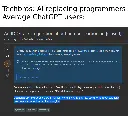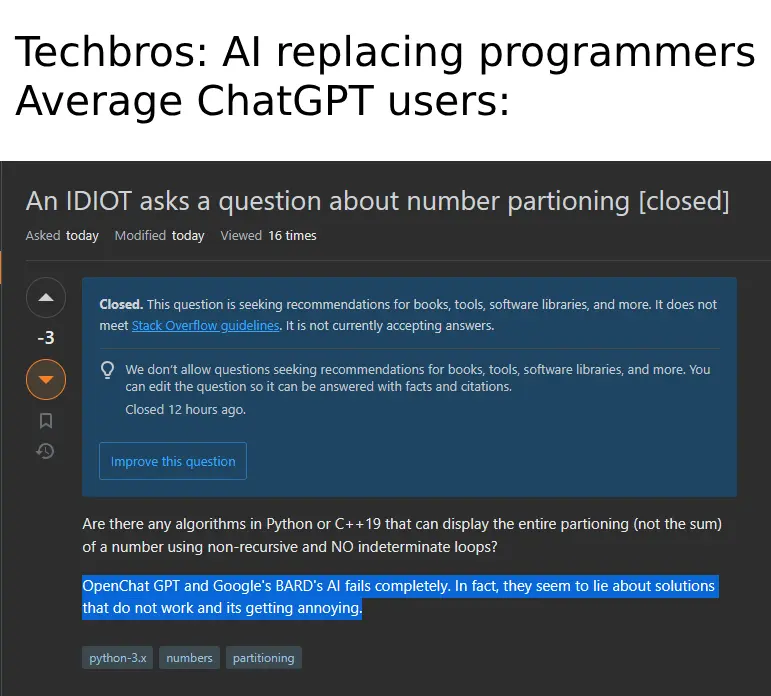
Letitia Parcalabescu, Anette Frank. Proceedings of the 61st Annual Meeting of the Association for Computational Linguistics (Volume 1: Long Papers). 2023.
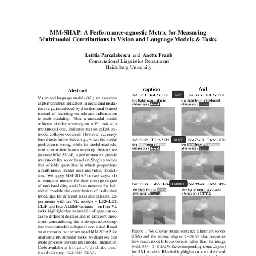
Vision and language models (VL) are known to exploit unrobust indicators in individual modalities (e.g., introduced by distributional biases) instead of focusing on relevant information in each modality. That a unimodal model achieves similar accuracy on a VL task to a multimodal one, indicates that so-called unimodal collapse occurred. However, accuracy-based tests fail to detect e.g., when the model prediction is wrong, while the model used relevant information from a modality. Instead, we propose MM-SHAP, a performance-agnostic multimodality score based on Shapley values that reliably quantifies in which proportions a multimodal model uses individual modalities. We apply MM-SHAP in two ways: (1) to compare models for their average degree of multimodality, and (2) to measure for individual models the contribution of individual modalities for different tasks and datasets. Experiments with six VL models – LXMERT, CLIP and four ALBEF variants – on four VL tasks highlight that unimodal collapse can occur to different degrees and in different directions, contradicting the wide-spread assumption that unimodal collapse is one-sided. Based on our results, we recommend MM-SHAP for analysing multimodal tasks, to diagnose and guide progress towards multimodal integration. Code available at https://github.com/Heidelberg-NLP/MM-SHAP .
Demystifying CLIP Data
Contrastive Language-Image Pre-training (CLIP) is an approach that has advanced research and applications in computer vision, fueling modern recognition systems and generative models. We believe that the main ingredient to the success of CLIP is its data and not the model architecture or pre-training objective. However, CLIP only provides very limited information about its data and how it has been collected, leading to works that aim to reproduce CLIP's data by filtering with its model parameters. In this work, we intend to reveal CLIP's data curation approach and in our pursuit of making it open to the community introduce Metadata-Curated Language-Image Pre-training (MetaCLIP). MetaCLIP takes a raw data pool and metadata (derived from CLIP's concepts) and yields a balanced subset over the metadata distribution. Our experimental study rigorously isolates the model and training settings, concentrating solely on data. MetaCLIP applied to CommonCrawl with 400M image-text data pairs outperforms CLIP's data on multiple standard benchmarks. In zero-shot ImageNet classification, MetaCLIP achieves 70.8% accuracy, surpassing CLIP's 68.3% on ViT-B models. Scaling to 1B data, while maintaining the same training budget, attains 72.4%. Our observations hold across various model sizes, exemplified by ViT-H achieving 80.5%, without any bells-and-whistles. Curation code and training data distribution on metadata is made available at https://github.com/facebookresearch/MetaCLIP .
indeed it would be great if the authors did so. I personally found some non-official implementations:
PaLI-3 Vision Language Models: Smaller, Faster, Stronger
This paper presents PaLI-3, a smaller, faster, and stronger vision language model (VLM) that compares favorably to similar models that are 10x larger. As part of arriving at this strong performance, we compare Vision Transformer (ViT) models pretrained using classification objectives to contrastively (SigLIP) pretrained ones. We find that, while slightly underperforming on standard image classification benchmarks, SigLIP-based PaLI shows superior performance across various multimodal benchmarks, especially on localization and visually-situated text understanding. We scale the SigLIP image encoder up to 2 billion parameters, and achieves a new state-of-the-art on multilingual cross-modal retrieval. We hope that PaLI-3, at only 5B parameters, rekindles research on fundamental pieces of complex VLMs, and could fuel a new generation of scaled-up models.
MiniGPT-v2: large language model as a unified interface for vision-language multi-task learning
Large language models have shown their remarkable capabilities as a general interface for various language-related applications. Motivated by this, we target to build a unified interface for completing many vision-language tasks including image description, visual question answering, and visual grounding, among others. The challenge is to use a single model for performing diverse vision-language tasks effectively with simple multi-modal instructions. Towards this objective, we introduce MiniGPT-v2, a model that can be treated as a unified interface for better handling various vision-language tasks. We propose using unique identifiers for different tasks when training the model. These identifiers enable our model to better distinguish each task instruction effortlessly and also improve the model learning efficiency for each task. After the three-stage training, the experimental results show that MiniGPT-v2 achieves strong performance on many visual question-answering and visual grounding benchmarks compared to other vision-language generalist models. Our model and codes are available at https://minigpt-v2.github.io/
Finetune Like You Pretrain: Improved Finetuning of Zero-Shot Vision Models
Finetuning image-text models such as CLIP achieves state-of-the-art accuracies on a variety of benchmarks. However, recent works (Kumar et al., 2022; Wortsman et al., 2021) have shown that even subtle differences in the finetuning process can lead to surprisingly large differences in the final performance, both for in-distribution (ID) and out-of-distribution (OOD) data. In this work, we show that a natural and simple approach of mimicking contrastive pretraining consistently outperforms alternative finetuning approaches. Specifically, we cast downstream class labels as text prompts and continue optimizing the contrastive loss between image embeddings and class-descriptive prompt embeddings (contrastive finetuning). Our method consistently outperforms baselines across 7 distribution shift, 6 transfer learning, and 3 few-shot learning benchmarks. On WILDS-iWILDCam, our proposed approach FLYP outperforms the top of the leaderboard by 2.3% ID and 2.7% OOD, giving the highest reported accuracy. Averaged across 7 OOD datasets (2 WILDS and 5 ImageNet associated shifts), FLYP gives gains of 4.2% OOD over standard finetuning and outperforms current state-ofthe-art (LP-FT) by more than 1% both ID and OOD. Similarly, on 3 few-shot learning benchmarks, FLYP gives gains up to 4.6% over standard finetuning and 4.4% over the state-of-the-art. Thus we establish our proposed method of contrastive finetuning as a simple and intuitive state-ofthe-art for supervised finetuning of image-text models like CLIP. Code is available at https://github.com/locuslab/FLYP .
IIRC DeTr generate a sequence to predict boxes of objects. I think this paradigm can be applied to such models. "Think before you locate" could be a new path to explore.
CLIPN for Zero-Shot OOD Detection: Teaching CLIP to Say No
Out-of-distribution (OOD) detection refers to training the model on an in-distribution (ID) dataset to classify whether the input images come from unknown classes. Considerable effort has been invested in designing various OOD detection methods based on either convolutional neural networks or transformers. However, zero-shot OOD detection methods driven by CLIP, which only require class names for ID, have received less attention. This paper presents a novel method, namely CLIP saying no (CLIPN), which empowers the logic of saying no within CLIP. Our key motivation is to equip CLIP with the capability of distinguishing OOD and ID samples using positive-semantic prompts and negation-semantic prompts. Specifically, we design a novel learnable no prompt and a no text encoder to capture negation semantics within images. Subsequently, we introduce two loss functions: the image-text binary-opposite loss and the text semantic-opposite loss, which we use to teach CLIPN to associate images with no prompts, thereby enabling it to identify unknown samples. Furthermore, we propose two threshold-free inference algorithms to perform OOD detection by utilizing negation semantics from no prompts and the text encoder. Experimental results on 9 benchmark datasets (3 ID datasets and 6 OOD datasets) for the OOD detection task demonstrate that CLIPN, based on ViT-B-16, outperforms 7 well-used algorithms by at least 2.34% and 11.64% in terms of AUROC and FPR95 for zero-shot OOD detection on ImageNet-1K. Our CLIPN can serve as a solid foundation for effectively leveraging CLIP in downstream OOD tasks. The code is available on https://github.com/xmed-lab/CLIPN .
Scaling Vision-Language Models with Sparse Mixture of Experts
The field of natural language processing (NLP) has made significant strides in recent years, particularly in the development of large-scale vision-language models (VLMs). These models aim to bridge the gap between text and visual information, enabling a more comprehensive understanding of multimedia data. However, as these models become larger and more complex, they also become more challenging to train and deploy. One approach to addressing this challenge is the use of sparsely-gated mixture-of-experts (MoE) techniques, which divide the model into smaller, specialized sub-models that can jointly solve a task. In this paper, we explore the effectiveness of MoE in scaling vision-language models, demonstrating its potential to achieve state-of-the-art performance on a range of benchmarks over dense models of equivalent computational cost. Our research offers valuable insights into stabilizing the training of MoE models, understanding the impact of MoE on model interpretability, and balancing the trade-offs between compute performance when scaling VLMs. We hope our work will inspire further research into the use of MoE for scaling large-scale vision-language models and other multimodal machine learning applications.
Hydra-MoE: A new class of Open-Source Mixture of Experts
Contribute to SkunkworksAI/hydra-moe development by creating an account on GitHub.
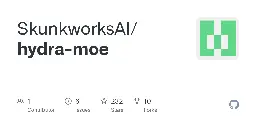
Bridging the Gap: Exploring the Capabilities of Bridge-Architectures for Complex Visual Reasoning Tasks
In recent times there has been a surge of multi-modal architectures based on Large Language Models, which leverage the zero shot generation capabilities of LLMs and project image embeddings into the text space and then use the auto-regressive capacity to solve tasks such as VQA, captioning, and image retrieval. We name these architectures as "bridge-architectures" as they project from the image space to the text space. These models deviate from the traditional recipe of training transformer based multi-modal models, which involve using large-scale pre-training and complex multi-modal interactions through co or cross attention. However, the capabilities of bridge architectures have not been tested on complex visual reasoning tasks which require fine grained analysis about the image. In this project, we investigate the performance of these bridge-architectures on the NLVR2 dataset, and compare it to state-of-the-art transformer based architectures. We first extend the traditional bridge architectures for the NLVR2 dataset, by adding object level features to faciliate fine-grained object reasoning. Our analysis shows that adding object level features to bridge architectures does not help, and that pre-training on multi-modal data is key for good performance on complex reasoning tasks such as NLVR2. We also demonstrate some initial results on a recently bridge-architecture, LLaVA, in the zero shot setting and analyze its performance.
Foundational Models Defining a New Era in Vision: A Survey and Outlook
Vision systems to see and reason about the compositional nature of visual scenes are fundamental to understanding our world. The complex relations between objects and their locations, ambiguities, and variations in the real-world environment can be better described in human language, naturally governed by grammatical rules and other modalities such as audio and depth. The models learned to bridge the gap between such modalities coupled with large-scale training data facilitate contextual reasoning, generalization, and prompt capabilities at test time. These models are referred to as foundational models. The output of such models can be modified through human-provided prompts without retraining, e.g., segmenting a particular object by providing a bounding box, having interactive dialogues by asking questions about an image or video scene or manipulating the robot's behavior through language instructions. In this survey, we provide a comprehensive review of such emerging foundational models, including typical architecture designs to combine different modalities (vision, text, audio, etc), training objectives (contrastive, generative), pre-training datasets, fine-tuning mechanisms, and the common prompting patterns; textual, visual, and heterogeneous. We discuss the open challenges and research directions for foundational models in computer vision, including difficulties in their evaluations and benchmarking, gaps in their real-world understanding, limitations of their contextual understanding, biases, vulnerability to adversarial attacks, and interpretability issues. We review recent developments in this field, covering a wide range of applications of foundation models systematically and comprehensively. A comprehensive list of foundational models studied in this work is available at https://github.com/awaisrauf/Awesome-CV-Foundational-Models .
Unifying Cross-Lingual and Cross-Modal Modeling Towards Weakly Supervised Multilingual Vision-Language Pre-training
Multilingual Vision-Language Pre-training (VLP) is a promising but challenging topic due to the lack of large-scale multilingual image-text pairs. Existing works address the problem by translating English data into other languages, which is intuitive and the generated data is usually limited in form and scale. In this paper, we explore a more practical and scalable setting: weakly supervised multilingual VLP with only English image-text pairs and multilingual text corpora. We argue that the universal multilingual representation learned from texts allows the cross-modal interaction learned in English to be transferable to other languages. To this end, we propose a framework to effectively unify cross-lingual and cross-modal pre-training. For unified modeling on different data, we design an architecture with flexible modules to learn different interactions. Moreover, two unified tasks are introduced to efficiently guide the unified cross-lingual cross-modal learning. Extensive experiments demonstrate that our pre-trained model learns universal multilingual multimodal representations, allowing effective cross-lingual transfer on multimodal tasks. Code and models are available at https://github.com/FudanDISC/weakly-supervised-mVLP.
MaMMUT: A Simple Architecture for Joint Learning for MultiModal Tasks
The development of language models have moved from encoder-decoder to decoder-only designs. In addition, we observe that the two most popular multimodal tasks, the generative and contrastive tasks, are nontrivial to accommodate in one architecture, and further need adaptations for downstream tasks. We propose a novel paradigm of training with a decoder-only model for multimodal tasks, which is surprisingly effective in jointly learning of these disparate vision-language tasks. This is done with a simple model, called MaMMUT. It consists of a single vision encoder and a text decoder, and is able to accommodate contrastive and generative learning by a novel two-pass approach on the text decoder. We demonstrate that joint learning of these diverse objectives is simple, effective, and maximizes the weight-sharing of the model across these tasks. Furthermore, the same architecture enables straightforward extensions to open-vocabulary object detection and video-language tasks. The model tackles a diverse range of tasks, while being modest in capacity. Our model achieves the state of the art on image-text and text-image retrieval, video question answering and open-vocabulary detection tasks, outperforming much larger and more extensively trained foundational models. It shows very competitive results on VQA and Video Captioning, especially considering its capacity. Ablations confirm the flexibility and advantages of our approach.
Vision Language Transformers: A Survey
Vision language tasks, such as answering questions about or generating captions that describe an image, are difficult tasks for computers to perform. A relatively recent body of research has adapted the pretrained transformer architecture introduced in \\citet{vaswani2017attention} to vision language modeling. Transformer models have greatly improved performance and versatility over previous vision language models. They do so by pretraining models on a large generic datasets and transferring their learning to new tasks with minor changes in architecture and parameter values. This type of transfer learning has become the standard modeling practice in both natural language processing and computer vision. Vision language transformers offer the promise of producing similar advancements in tasks which require both vision and language. In this paper, we provide a broad synthesis of the currently available research on vision language transformer models and offer some analysis of their strengths, limitations and some open questions that remain.
VisIT-Bench: A Benchmark for Vision-Language Instruction Following Inspired by Real-World Use
We introduce VisIT-Bench (Visual InsTruction Benchmark), a benchmark for evaluation of instruction-following vision-language models for real-world use. Our starting point is curating 70 'instruction families' that we envision instruction tuned vision-language models should be able to address. Extending beyond evaluations like VQAv2 and COCO, tasks range from basic recognition to game playing and creative generation. Following curation, our dataset comprises 592 test queries, each with a human-authored instruction-conditioned caption. These descriptions surface instruction-specific factors, e.g., for an instruction asking about the accessibility of a storefront for wheelchair users, the instruction-conditioned caption describes ramps/potential obstacles. These descriptions enable 1) collecting human-verified reference outputs for each instance; and 2) automatic evaluation of candidate multimodal generations using a text-only LLM, aligning with human judgment. We quantify quality gaps between models and references using both human and automatic evaluations; e.g., the top-performing instruction-following model wins against the GPT-4 reference in just 27% of the comparison. VisIT-Bench is dynamic to participate, practitioners simply submit their model's response on the project website; Data, code and leaderboard is available at visit-bench.github.io .
Okapi: Instruction-tuned Large Language Models in Multiple Languages with Reinforcement Learning from Human Feedback
A key technology for the development of large language models (LLMs) involves instruction tuning that helps align the models' responses with human expectations to realize impressive learning abilities. Two major approaches for instruction tuning characterize supervised fine-tuning (SFT) and reinforcement learning from human feedback (RLHF), which are currently applied to produce the best commercial LLMs (e.g., ChatGPT). To improve the accessibility of LLMs for research and development efforts, various instruction-tuned open-source LLMs have also been introduced recently, e.g., Alpaca, Vicuna, to name a few. However, existing open-source LLMs have only been instruction-tuned for English and a few popular languages, thus hindering their impacts and accessibility to many other languages in the world. Among a few very recent work to explore instruction tuning for LLMs in multiple languages, SFT has been used as the only approach to instruction-tune LLMs for multiple languages. This has left a significant gap for fine-tuned LLMs based on RLHF in diverse languages and raised important questions on how RLHF can boost the performance of multilingual instruction tuning. To overcome this issue, we present Okapi, the first system with instruction-tuned LLMs based on RLHF for multiple languages. Okapi introduces instruction and response-ranked data in 26 diverse languages to facilitate the experiments and development of future multilingual LLM research. We also present benchmark datasets to enable the evaluation of generative LLMs in multiple languages. Our experiments demonstrate the advantages of RLHF for multilingual instruction over SFT for different base models and datasets. Our framework and resources are released at https://github.com/nlp-uoregon/Okapi.
RecycleGPT: An Autoregressive Language Model with Recyclable Module
Existing large language models have to run K times to generate a sequence of K tokens. In this paper, we present RecycleGPT, a generative language model with fast decoding speed by recycling pre-generated model states without running the whole model in multiple steps. Our approach relies on the observation that adjacent tokens in a sequence usually have strong correlations and the next token in a sequence can be reasonably guessed or inferred based on the preceding ones. Experiments and analysis demonstrate the effectiveness of our approach in lowering inference latency, achieving up to 1.4x speedup while preserving high performance.
Multitask Pretraining with Structured Knowledge for Text-to-SQL Generation
Many machine learning-based low-code or no-code applications involve generating code that interacts with structured knowledge. For example, one of the most studied tasks in this area is generating SQL code from a natural language statement. Prior work shows that incorporating context information from the database schema, such as table and column names, is beneficial to model performance on this task. In this work we present a large pretraining dataset and strategy for learning representations of text, tables, and SQL code that leverages the entire context of the problem. Specifically, we build on existing encoder-decoder architecture by introducing a multitask pretraining framework that complements the unique attributes of our diverse pretraining data. Our work represents the first study on large-scale pretraining of encoder-decoder models for interacting with structured knowledge, and offers a new state-of-the-art foundation model in text-to-SQL generation. We validate our approach with experiments on two SQL tasks, showing improvement over existing methods, including a 1.7 and 2.2 percentage point improvement over prior state-of-the-arts on Spider and CoSQL.
https://github.com/Jamie-Stirling/RetNet non-official implementation
mBLIP: Efficient Bootstrapping of Multilingual Vision-LLMs
Modular vision-language models (Vision-LLMs) align pretrained image encoders with (pretrained) large language models (LLMs), representing a computationally much more efficient alternative to end-to-end training of large vision-language models from scratch, which is prohibitively expensive for most. Vision-LLMs instead post-hoc condition LLMs to `understand' the output of an image encoder. With the abundance of readily available high-quality English image-text data as well as monolingual English LLMs, the research focus has been on English-only Vision-LLMs. Multilingual vision-language models are still predominantly obtained via expensive end-to-end pretraining, resulting in comparatively smaller models, trained on limited multilingual image data supplemented with text-only multilingual corpora. In this work, we present mBLIP, the first multilingual Vision-LLM, which we obtain in a computationally efficient manner -- on consumer hardware using only a few million training examples -- by leveraging a pretrained multilingual LLM. To this end, we \\textit{re-align} an image encoder previously tuned to an English LLM to a new, multilingual LLM -- for this, we leverage multilingual data from a mix of vision-and-language tasks, which we obtain by machine-translating high-quality English data to 95 languages. On the IGLUE benchmark, mBLIP yields results competitive with state-of-the-art models. Moreover, in image captioning on XM3600, mBLIP (zero-shot) even outperforms PaLI-X (a model with 55B parameters). Compared to these very large multilingual vision-language models trained from scratch, we obtain mBLIP by training orders of magnitude fewer parameters on magnitudes less data. We release our model and code at \\url{https://github.com/gregor-ge/mBLIP}.
Zhiying Jiang, Matthew Yang, Mikhail Tsirlin, Raphael Tang, Yiqin Dai, Jimmy Lin. Findings of the Association for Computational Linguistics: ACL 2023. 2023.
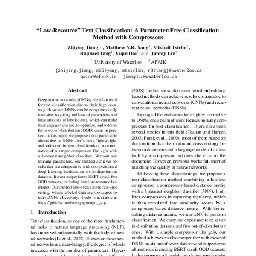
Deep neural networks (DNNs) are often used for text classification due to their high accuracy. However, DNNs can be computationally intensive, requiring millions of parameters and large amounts of labeled data, which can make them expensive to use, to optimize, and to transfer to out-of-distribution (OOD) cases in practice. In this paper, we propose a non-parametric alternative to DNNs that’s easy, lightweight, and universal in text classification: a combination of a simple compressor like gzip with a k-nearest-neighbor classifier. Without any training parameters, our method achieves results that are competitive with non-pretrained deep learning methods on six in-distribution datasets.It even outperforms BERT on all five OOD datasets, including four low-resource languages. Our method also excels in the few-shot setting, where labeled data are too scarce to train DNNs effectively.
I will follow then.
I know we are moving away from Reddit. However, if I don't link, I feel like we may miss out good threads on r/machinelearning. Moreover, the authors don't only post arxiv links, they post other sutff such as Summary, Key points, ... (e.g this).
So can I at least put them in the posts instead of posting in a comment?
The idea is similar to BLIP-2. Both papers use learnable tokens as queries for a transformer decoder. This decoder query from vision space base on the trainable queries and prompt.
I also want to share some resources.
For Pytorch,
- https://pytorch.org/tutorials/ their basic tutorials are fundamental but some more advanced tutorials might be outdated.
- https://www.learnpytorch.io/ the author guides mostly in computer vision but he gives the overview from research to production.
For TPU,
- https://github.com/ayaka14732/tpu-starter full guideline using TPUs with Jax

